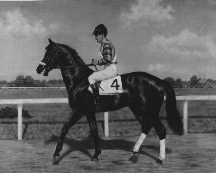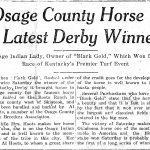May 18, 1924
The Pawhuska Capital
Microfilm Roll: MN00342
On this day in Osage country The Pawhuska Capital announced the winner of the Kentucky Derby, an Osage horse named Black Gold.
Horse racing played a significant role in Oklahoma’s history. It was first practiced by the Indians and later became a favorite sport among all. By the late 1800s, both Indians and whites agreed “that racing horses was the most popular sport of the nineteenth century” (Everett). It continued to be immensely popular throughout the 1900s and especially so after the First World War.
The story of Black Gold is similar to that of a fairy tale. Rosa Hoots, Black Gold’s owner, was an Osage tribal member. Rosa and her husband Alfred used their ranch, Hoots Ranch, to rear, breed, and train race horses, a tradition that Rosa and her children continued even after Alfred’s passing in 1917. Eight years prior to his passing, Alfred invested in a mare by the name of U-See-It who proved to be a very talented race horse, winning over thirty races in a matter of only seven years. Rosa’s final promise to her husband was that “U-See-It would have an offspring in the Kentucky Derby” (Warehime).

Black Gold, the son of U-See-It, was born in February 1921. By the time he reached two years of age, Black Gold had already begun racing, winning his first race in Louisiana in January of 1923. At three, Black Gold would go on to win the Louisiana Derby which qualified him as a contender for the Kentucky Derby. Then in the summer of 1924, Black Gold came in first place in the 1924 Kentucky Derby, garnering Rosa with a “fourteen karat gold trophy” and over $50,000 in prize money (Warehime). Furthermore, in winning both the Louisiana and Kentucky derbies Black Gold set a record that “went unmatched for more than seventy years” (Groom). That same year Black Gold went on to place in at least four other races including the Ohio Derby and Chicago Derby.
Unfortunately, after a rewarding year of racing, Black Gold suffered an injury to his left foreleg. Due to the injury, Ms. Hoots decided to retire Black Gold as a stud; however, he proved to be sterile. In 1927, Hanley Web, Black Gold’s trainer, began training the horse again, a decision made in the oversight of possible negative outcomes of the leg injury. Black Gold once again began racing in the winter of that same year and, after three races, never placed. At the start of the 1928 racing season, Black Gold was put down having further injured his leg on a New Orleans track.
Even decades after his passing, the legend of Black Gold is still being commemorated. In 1947 a film titled Black Gold was released that is said to have been loosely based on the legend of Black Gold. The film starred Anthony Quinn as one of the main characters. Later, in 1971, Black Gold was inaugurated into the Fair Grounds Hall of Fame in New Orleans, Louisiana, the location of his death and burial, and in 1989 was even inducted into the National Museum of Racing Hall of Fame.
Morgan M. Guzman
“Osage County Horse Latest Derby Winner.” The Pawhuska Capital. May 18, 1924, p. 1. Microfilm roll number MN00342. Sequoyah National Research Center, Little Rock, Arkansas.
Further Reading
“Black Gold (USA)” American Classic Pedigrees http://www.americanclassicpedigrees.com/black-gold.html. Accessed February 5, 2018.
“Black Gold (1947),” IMDB http://www.imdb.com/title/tt0039191/. Accessed February 5, 2018)
“Black Gold,” National Museum of Racing and Hall of Fame, https://www.racingmuseum.org/hall-of-fame/black-gold. Accessed February 5, 2018.
Everett, Dianna. “Horse Racing.” The Encyclopedia of Oklahoma History and Culture. http://www.okhistory.org/publications/enc/entry.php?entry=HO046. Accessed February 2, 2018.
Groom, Winston. “The Legend of Black Gold.” Garden and Gun. http://gardenandgun.com/feature/the-legend-of-black-gold/. Accessed February 2, 2018.
Warehime, Les. “Hoots Ranch.” The Encyclopedia of Oklahoma History and Culture. http://www.okhistory.org/publications/enc/entry.php?entry=HO043. Accessed February 2, 2018.
